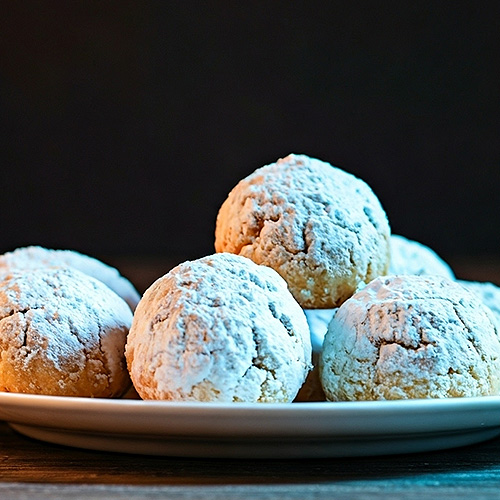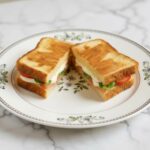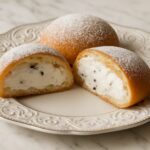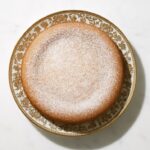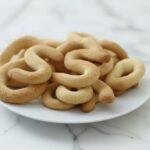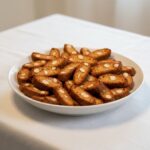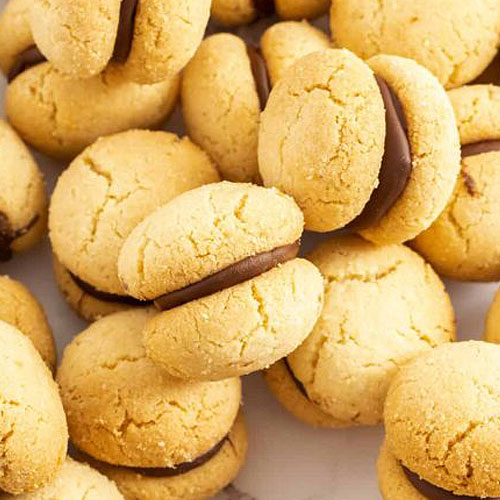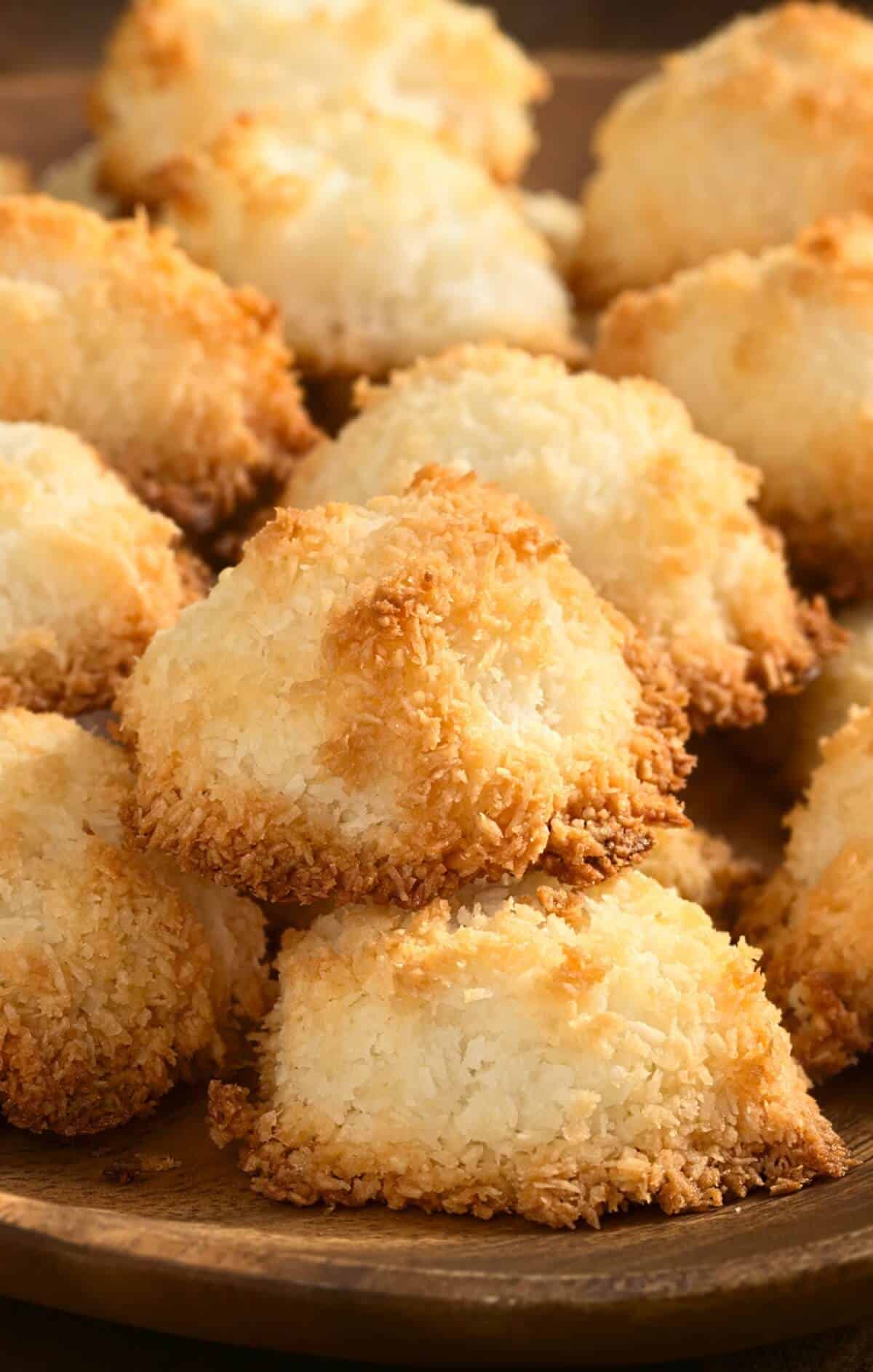Magic of the First Bite
You know that feeling when you bite into a Kourabie? Pure magic. The cookie melts in your mouth, buttery, soft, and just crumbly enough. Then comes the crunch of roasted almonds and a cloud of powdered sugar that lingers like fresh snow.
A Sweet Symbol of Celebration
In Greece, Kourabiedes play a central role in life’s most cherished celebrations. For example, at weddings, they’re often stacked high in elegant pyramids, sweet symbols of joy and good fortune. During Christmas, they shine on silver trays, representing warmth, generosity, and the joy of giving. But Kourabiedes are more than just cookies. In fact, they’re edible tradition.
Likewise, they make appearances at Easter and name days, often brought out like old friends, always expected, always appreciated.
A Taste of Greek Heritage
Baking Kourabiedes isn’t just about making a treat; it’s about creating moments. As the toasted almonds release their aroma and flour dust swirls in the air, something special happens. Families gather, grandmothers, mothers, and children shaping dozens (or even hundreds) of cookies by hand. It’s not a task; rather, it’s a ritual. There’s laughter, storytelling, and a deep sense of connection passed down through generations.
Whether served at a holiday table or given as a gift, these cookies carry the essence of Greek hospitality.
- 1½ cup unsalted butter, at room temperature
- 1 large egg yolk
- ¾ cup powdered sugar
- 1 tbsp brandy or cognac
- 1 tsp vanilla extract
- 3½ cups all-purpose flour, sifted
- ½ tsp baking powder
- 1 cup toasted almonds, finely chopped
- 2 cups Extra powdered sugar for coating
- 2 tbsp Rosewater or orange blossom water (optional)
- Whole cloves (optional)
Toast the almonds in a dry skillet or 350°F (175°C) oven for about 8–10 minutes. Let cool and finely chop.
Cream the Butter and Sugar: Using a stand or hand mixer, beat the butter for about 5–7 minutes until light, fluffy, and almost white in color. Add the powdered sugar and continue beating until well combined.
Add Wet Ingredients: Mix in the egg yolk, brandy, and vanilla extract until incorporated.
Add Dry Ingredients: In a separate bowl, sift together the flour and baking powder. Gradually add the flour mixture to the butter mixture. Fold in the chopped toasted almonds. The dough should be soft but not sticky. If needed, add a bit more flour.
In a separate bowl, sift together the flour and baking powder. Gradually add the flour mixture to the butter mixture. Fold in the chopped toasted almonds. The dough should be soft but not sticky. If needed, add a bit more flour.
Preheat oven to 350°F (175°C). Line a baking sheet with parchment paper.
Roll dough into small balls (about 1 inch in diameter) or shape into crescents. Place them 1 inch apart on the baking sheet.
Bake for 18–22 minutes, or until the bottoms are golden but the tops remain pale.
Cool & Dust: Let cookies cool for 5 minutes on the baking sheet, then carefully transfer to a wire rack. While still warm (but not hot), sift powdered sugar generously over the cookies.
Optional: Sprinkle rosewater or orange blossom water over the cookies just before dusting them with powdered sugar.
Once fully cooled, roll them again in powdered sugar for the classic thick coating.
Use high-quality butter: The flavor of Kourabiedes depends heavily on the butter. Traditional versions use clarified sheep or goat butter for a deep, nutty taste. If that’s not available, use the best-quality unsalted butter you can find, it makes all the difference.
Don’t skip the toasted almonds: Toasting the almonds before mixing them into the dough brings out their full aroma and flavor. Chop them coarsely for texture, or finely for a more delicate crumb — both are traditional.
Chill the dough before shaping: Chilling helps the dough firm up, making it easier to roll and shape. It also keeps the cookies from spreading too much in the oven.
Shape with care: You can form Kourabiedes into rounds, crescents, or domes. There’s no one “right” way — shape them how your yiayia (grandma) did or however feels festive to you.
Dust while warm, coat when cool: Lightly dust the cookies with powdered sugar while they’re still warm so it sticks. Once they cool completely, generously coat them in a thick layer of powdered sugar, enough to look like fresh snow.
Serving
In Greece, Kourabiedes are more than holiday treats, they’re symbols of hospitality, celebration, and good fortune. They’re often made in huge batches and shared with friends, neighbors, and guests. You’ll find them on every Greek Christmas table.
Serve with a small cup of Greek coffee, espresso, or even a splash of ouzo or brandy for a cozy, festive moment.
Storage
Storing Kourabiedes properly is key to preserving their delicate texture and rich flavor. Once they’ve cooled completely, layer them gently in an airtight container, placing parchment paper between each layer to protect the powdered sugar coating. Keep the container in a cool, dry spot, avoid the fridge, as humidity can cause the sugar to melt and make the cookies soggy. When stored this way, they’ll stay fresh for up to two weeks, and truthfully, they often taste even better after a day or two as the buttery flavor deepens. Planning ahead? You’re in luck — Kourabiedes freeze beautifully. You can freeze the raw, shaped dough (without sugar) and bake it straight from the freezer, adding a minute or two to the baking time. Baked cookies can also be frozen, but it’s best to leave off the powdered sugar until you’re ready to serve. They can be frozen for up to 2 to 3 months. Just thaw at room temperature and give them a fresh snowy dusting before plating, no one will ever know they weren’t made that morning.
Like this:
Like Loading...

